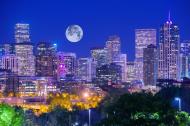2016 Draconid Meteor Shower
The 2016 Draconid meteor shower is expected to reach its peak on October 8. A first Quarter Moon may make it harder for observers to see many shooting stars.

Draconids are also known as Giacobinids
©iStockphoto.com/Clint Spencer
The best time to see the shower is right before nightfall.
Sunrise and Sunset in my CityTwo meteor showers in October
The Draconid meteor shower, also sometimes known as the Giacobinids, is one of the two meteor showers to annually grace the skies in October. The Draconids owe their name to the constellation Draco the Dragon, and are created when the Earth passes through the dust debris left by comet 21 P/ Giacobini-Zinner. The comet takes about 6.6 years to make a single revolution around the Sun.
Although the Draconids have been responsible for some of the most spectacular meteor showers in recorded history, most recently in 2011, most astronomers and sky gazers consider these to be one of the least interesting meteor showers in during the year.
The Orionids are the second meteor shower in October. It usually peaks around October 21.
Location in the sky
The Draconids meteor shower is not visible at this time of year. The best date is around Oct 8, 2016, table below is for that date:| Draconids meteor shower for Washington DC (Night between Oct 8 and Oct 9) | ||
|---|---|---|
| Time | Azimuth/Direction | Altitude |
| Sat 8:00 PM | 313° | 59.7° |
| Sat 9:00 PM | 311° | 51.0° |
| Sat 10:00 PM | 312° | 42.2° |
| Sat 11:00 PM | 315° | 33.7° |
| Midnight Sat-Sun | 320° | 25.8° |
| Sun 1:00 AM | 326° | 18.7° |
| Sun 2:00 AM | 332° | 12.7° |
| Sun 3:00 AM | 340° | 8.0° |
| Sun 4:00 AM | 348° | 4.8° |
| Sun 5:00 AM | 357° | 3.3° |
| Sun 6:00 AM | 6° | 3.5° |
Set your location
Where can I see the Draconids From?
Viewers in Northern America, Europe and Asia are the best situated to enjoy the Draconids. Those closer to the Equator in the Southern Hemisphere can also sometimes see few meteors from the Draconids.
While it is not necessary to look in a particular direction to enjoy a meteor shower – just lie down on the ground and look directly above and you are bound to see some meteors – astronomers suggest locating the Draco the Dragon's two brightest stars, Eltanin and Rastaban. The meteor shower seems to emerge from the dragon’s head.
When to view the Draconids
Unlike its counterparts, the best time to view the Draconids is just after the Sun sets and right before nightfall. This is because, the Draconids’ radiant point - the point in the sky where the meteor shower seems to come from - is highest in the sky during dusk. The shower peaks around October 7 and 8 every year.
How to view the Draconids
There isn’t a lot of skill involved in watching a meteor shower. Here are some tips on how to maximize your time looking for the Draconids:
- Get out of the city to a place where city and artificial lights do not impede your viewing
- If you are out viewing the shower during its peak, you will not need any special equipment. You should be able to see the shower with your naked eyes.
- Carry a blanket or a comfortable chair with you - viewing meteors, just like any other kind of star gazing is a waiting game, and you need to be comfortable. Plus, you may not want to leave until you can’t see the majestic celestial fireworks anymore.
- Check the weather and moonrise and moonset timings for your location before you leave, and plan your viewing around it.
In This Article
- Two meteor showers in October
- Where can I see the Draconids From?
- When to view the Draconids
- How to view the Draconids

Meteor Showers Library
- April 2016: Lyrids
- May 2016: Eta Aquarids
- August 2016: Perseids
- October 2016: Draconids
- October 2016: Orionids
- November 2016: Leonids
- December 2016: Geminids
- December 2016: Ursids
- January 2017: Quadrantids






Share this page / Follow us on:
Visit us on: